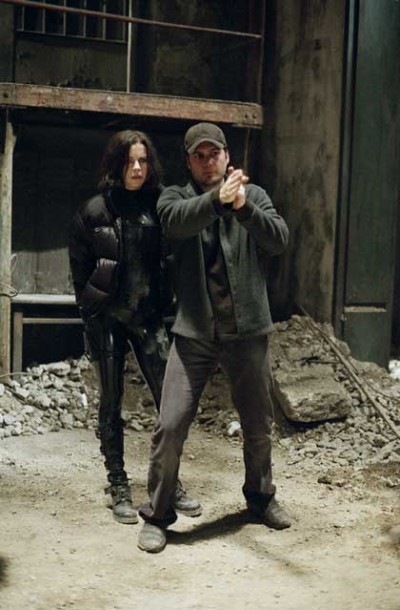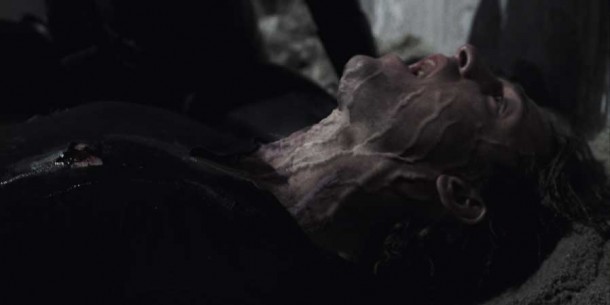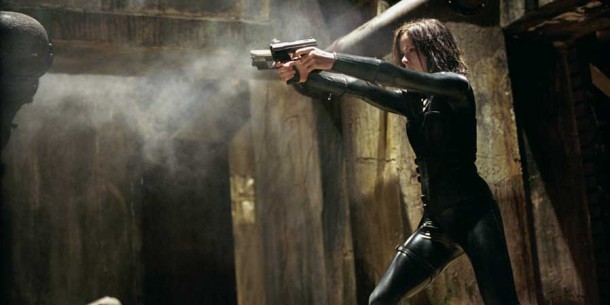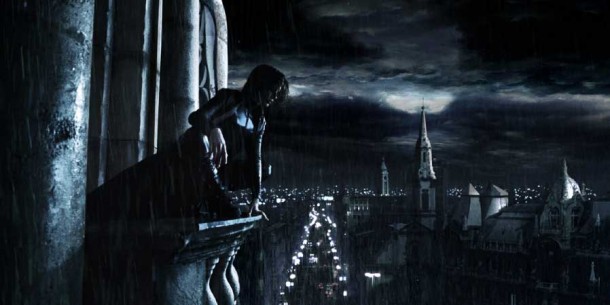Discover the “Underworld”
An interview with Rob Duncan from Framestore-CFC on the FX of UNDERWORLD
Kate Beckinsale with Director Len Wideman on the set of the Screen Gems/Lakeshore Entertainment thriller Underworld.
Long leather trench coats, cool shades, big guns and dark alleys, does this sound familiar? If this film didn’t have vampires and werewolves, it would probably resemble like yet an other episode of “The Matrix”. Underworld is an extremely stylish, beautiful film. I had the chance to attend the premiere this week. I must admit I entered the theater with mixed feelings about the film. But I was not disappointed. Underworld is what it is. A Romeo and Juliet tale with a twist.
We recently had the chance to interview Rob Duncan from Framestore-CFC who supervised the digital VFX on Underworld.
CGC: Can you give us a quick breakdown of the work you have done on the film “Underworld”?
RD: We were primarily concerned with transformations from human form (although the characters were not necessarily human to begin with) in to seven-foot tall werewolves.
Other complicated 3D work included sequences where vampires would burn up due to exposure to sunlight or special UV bullets developed by the werewolves; and in retaliation, werewolves being incapacitated due to silver nitrate flowing through their veins from special bullets developed by the vampires.
Image above: Michael Corvin (Scott Speedman) transforms into a werewolf.
We also created the internal organs for the Victor character for a sequence where we go inside his body to see how he regenerates after having been asleep for 100 years.
Simpler, or more invisible, 3D work comprised of rigid body models of a crypt cover (when Victor is resurrected), Lucian’s sword, Selene’s star-weapons, and some bullets which Lucian expels from his body after being shot by Selene.
We also produced a lot of 2D comp work throughout the film, including the opening sequence which was put together with a mixture of night exteriors, dusk-for-night exteriors, studio sets and digital set extensions with practical and digital rain.
CGC: Tell us about the transformation sequences you created?
RD: In most cases the scene containing the transformation would be shot with the relevant actor in their human form, and then a stuntman in a werewolf costume would take over after the transformation was complete – our job was to fill in the gap.
We knew from the start that a straight morph between two live action plates would not be sufficient for the transformations the director Len Wiseman had in mind. Therefore we used a combination of cyberscans and turntable photographic stills to replicate the shape and detail of the characters before and after the transformation process. This way, we could line up our digital doubles to register perfectly with the chosen live action plate.
We would typically match up to the human form, using the body movement of the live action to produce the underlying animation (head turns etc), and then keyframe our own facial expressions and subtle body shifts as we ‘blended’ through to the werewolf form – by the end of the shot the intention was to get our digital werewolf to match as closely as possible to the live action reference of the werewolf costume.
We were aiming to create a transformation style whereby you could see the bones shifting underneath the skin and muscle – for instance, the jawbone moving at a different rate and in a different direction to the plates in the skull to prevent the change from looking too smooth or morph-like.
We had full control over the amount of ‘blending’ between human form and werewolf – that is, the percentage of human shape size and texture versus the percentage of werewolf shape size and texture. This turned out to be of most use when we had to transform the Michael character, who becomes a hybrid creature of vampire and werewolf – for example, we could utilize 100% of the werewolf skin texture on a body shape that was still 60% human.
CGC: What was the most difficult part of the transformation?
RD: Probably the hair, although we were lucky that the werewolves were mainly smooth-skinned, with only tufts of hair down the middle of the head, neck and back, with some long strands on the arms and legs. It is still very difficult to digitally create realistic-looking hair, let alone see it growing during a shot.
CGC: We are far from the days of “Elastic Reality” transformations, what kind of tools were used here?
RD: We used a mixture of Houdini and Maya, combining procedural and keyframe animation methods to get the best results. This was also true for the transformation of Victor’s internal organs. I should also point out that as part of the comping process we also used Inferno’s warper to assist in refining the 3D tracking, so that we had a perfect match for every frame where required.
CGC: In the trailer, we see the werewolves running off the walls; did Framestore-CFC create these?
RD: No, this was actually a single stuntman in a costume suspended on wires, which we replicated to make into a pack of werewolves. We did a lot of work to make them interact with the walls, shooting lots of practical dust and debris, and digitally painting in gouge marks and bullet holes in the wake of the werewolves.
However, as post-production progressed it became apparent that there were a few instances where a shot of a werewolf would be helpful to tell the story more clearly – because we already had the model built for the transformations, we were able to provide some shots with a fully animated creature at fairly short notice, with some other shots being done as a conventional live action pick-up shoot.
What is the next in the production pipeline at Framestore-CFC as far as feature-film projects go?
We are currently involved in extensive work on Harry Potter 3, Thunderbirds, and Troy
CGC: When The Mill shut down its film division, it seemed for a while that the VFX industry for film was dead. What’s your take on the matter?
RD: I assume you mean the London film-VFX industry – if so, then this would be like saying that if Liverpool FC (insert team of your choice here) went out of business, then that would be the death of football! On the contrary, at the time, everyone else in London was either very busy or crewing up for the big projects which are now in post-production
Big thanks to Rob Duncan and Framestore-CFC for making this story possible.
Related Links:
All images in this story are the property of Screen Gems
Release dates (Source: IMDB):
Canada – 8 September 2003 (Toronto Film Festival)
UK – 19 September 2003
USA – 19 September 2003
France – 24 September 2003
Czech Republic – 25 September 2003
Greece – 3 October 2003
Iceland – 3 October 2003
Belgium – 8 October 2003
South Korea – 10 October 2003
Australia – 16 October 2003
Russia – 16 October 2003
Spain – 17 October 2003
Denmark – 14 November 2003
Netherlands – 27 November 2003
Norway – 30 November 2003
New Zealand – 4 December 2003
Argentina – 26 February 2004




